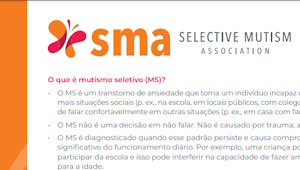Online Library
Parent Letter to Teacher of Student with Selective Mutism
How to Share Information About Your Child’s SM with Their Teacher
Teachers are typically confused by a student with selective mutism (SM). They often have not yet had a student with SM and don’t know what to do to help. Their efforts to make the child comfortable are sometimes counterproductive as they may default to asking yes/no questions, which leads the child with SM to continue nodding, instead of talking. Experience tells us that when teachers are given good techniques to use, they really appreciate it and the skills work. Depending on your own situation, you may be the one, as the parent, who will teach the skills to the teacher.
In any event, we encourage you to write a letter to the teacher like the one below. Feel free to take the one below and edit it to your liking. Personalize it to your child’s situation.
**********************************
Sample Letter
Dear [teacher]:
Our daughter, Sophia, has selective mutism (“SM”), which is a type of social anxiety disorder. At home, or in reduced-anxiety settings, she is loquacious and articulate. But in most settings with unfamiliar places or persons, she shuts down and will not respond when spoken to. At her last school, she went a whole year without speaking with her peers or teachers beyond responding minimally when addressed.
Selective mutism is not shyness. It is not intentional, nor is it willful. It can be debilitating.
Sophia is a child with special needs. Even if she begins to respond in certain situations, her anxiety prevents her from participating in activities she wants to take part in, and stops her from speaking up, for help, for assistance, or for the sake of speaking up.
Here’s the best thing about SM: it’s treatable. But she’s dependent on those around her to help her develop her ‘brave talking’ – without ignoring her, and yet without pushing her. Setting up the right environment to encourage Sophia to speak is very important! A setting or person, once ‘contaminated’ may remain so without specifically targeting it as a treatment goal.
Kids with SM can be more vulnerable to bullying or distress at school because they cannot summon the voice to seek help or even ask for clarification. As we mentioned, Sophia did not talk unprompted for a whole year at her previous school. But the most concerning for us was that despite being potty-trained, she could not ask a teacher to take her to the bathroom. Not once. And that is why we need her to be truly talking in a school setting, and not just responding, so that she can ask for help if she needs it. You’ll know when her anxiety is at bay when Sophia starts asking you questions, which she does, non-stop.
Her anxiety about talking and social settings has to be managed in order for her to function. We had enrolled Sophia at karate school at the beginning of this year. Unfortunately as we did before her SM diagnosis, we didn’t develop a plan to help her feel more comfortable with the karate teachers. She was somewhat responsive to the teacher because she really enjoyed karate – and still does – and we took it as a success compared to her past non-verbal experiences. A few months later, she started crying inconsolably during class and was unable to say what was wrong because nothing ‘visible’ had happened. It was anxiety. Something had triggered an anxious response in an environment where her SM was not understood. For eight weeks after that incident, we tried to help her re-engage at karate. She wanted to go each time. But once inside the classroom, she would be rendered paralyzed and in distress, unable to take a single step forward, regardless of the reward or encouragement offered, all the while repeating, ‘I don’t know how to do it, I don’t know how to move forward.’ In the end, we withdrew her from the program. This is what her SM, left unchecked, can look like. But please note that Sophia’s SM is manageable and treatable.
Sophia has been making significant strides recently, through the application of strategies we have been researching and applying, and we are so proud of her progress. We know that if we work together, we can maintain the progress she’s made and also challenge her to grow in her bravery even more!
Through these practices, we have learned several strategies that help Sophia to feel more comfortable talking more quickly. We hope you will consciously incorporate the following steps in your interactions with her to help her initiate conversations.
- Sophia will need some time to warm up at the beginning of each day and especially following breaks from school. During this warm-up time, avoid asking direct questions. Instead, make comments about what she is doing and offer subtle praise if she does communicate with you.
- As much as possible, keep the activities light and enjoyable where she doesn’t feel significant pressure to speak. Playing games with a verbal component (such as Guess Who, I spy, or Spot It) can make “brave work” feel less like “work.”
- Sophia does her best “brave talking” when she is alone with the new person. Eventually, we will want to encourage her to talk in front of her reading group and do show n’ tell, but right now, we need to focus on helping her to feel comfortable speaking with you, her teacher, alone. We would love to find a time to schedule a private visit with you outside of school hours for the purpose of establishing speech.
- Do encourage her to practice her brave talking. Please avoid asking her any ‘yes/no’ questions and help her use her brave muscles by giving her forced choice questions (ex: “Do you want A, B, or something else?”). Reflecting what she says, and then praising her, and telling her why she’s being praised can do wonders. Yes/no questions make it too easy for kids like Sophia to just nod back to you.
- Please allow Sophia extra time to answer questions, at least five (5) seconds. Avoid direct eye contact when awaiting her response, if necessary, as staring makes you both needlessly uncomfortable.
SM may be new to you (as it was recently to us!) and you may have questions. We are happy to help address what we can, but we’d also like to share some great resources about SM. First, the Selective Mutism Association (SMA) developed a great toolkit for educators. There are many other resources on the SMA website too, such as webinars, conferences, and a whole section of documents dedicated to increasing school communication. In addition, there is a free, online course that we would really encourage you to take to learn more about all of these skills. It even has some cool videos showing how to use the specific skills. Here’s the SM University website:
Please let us know how best to communicate with you regarding Sophia’s progress in brave talking so we can collaboratively modify her goals accordingly. Up until now, we, her parents, have been her main SM stewards. From next month on, we will be sharing that role with you. And we are so grateful for your willingness and support in helping Sophia along her journey of brave talking. We are optimistic that by working together in helping her thrive in pre-school, we can set her up for long term success and life enrichment. Thank you.
Sincerely,




